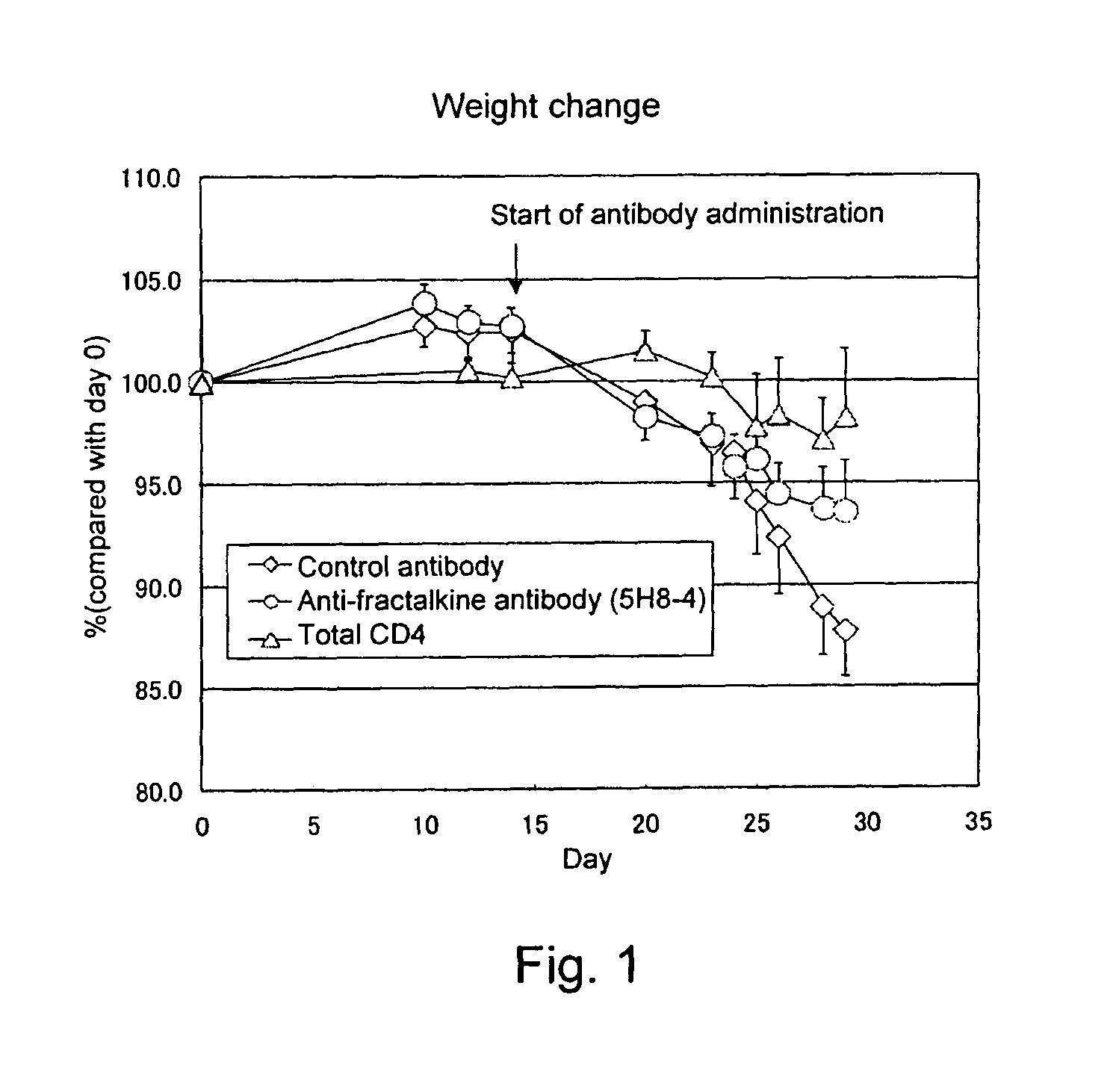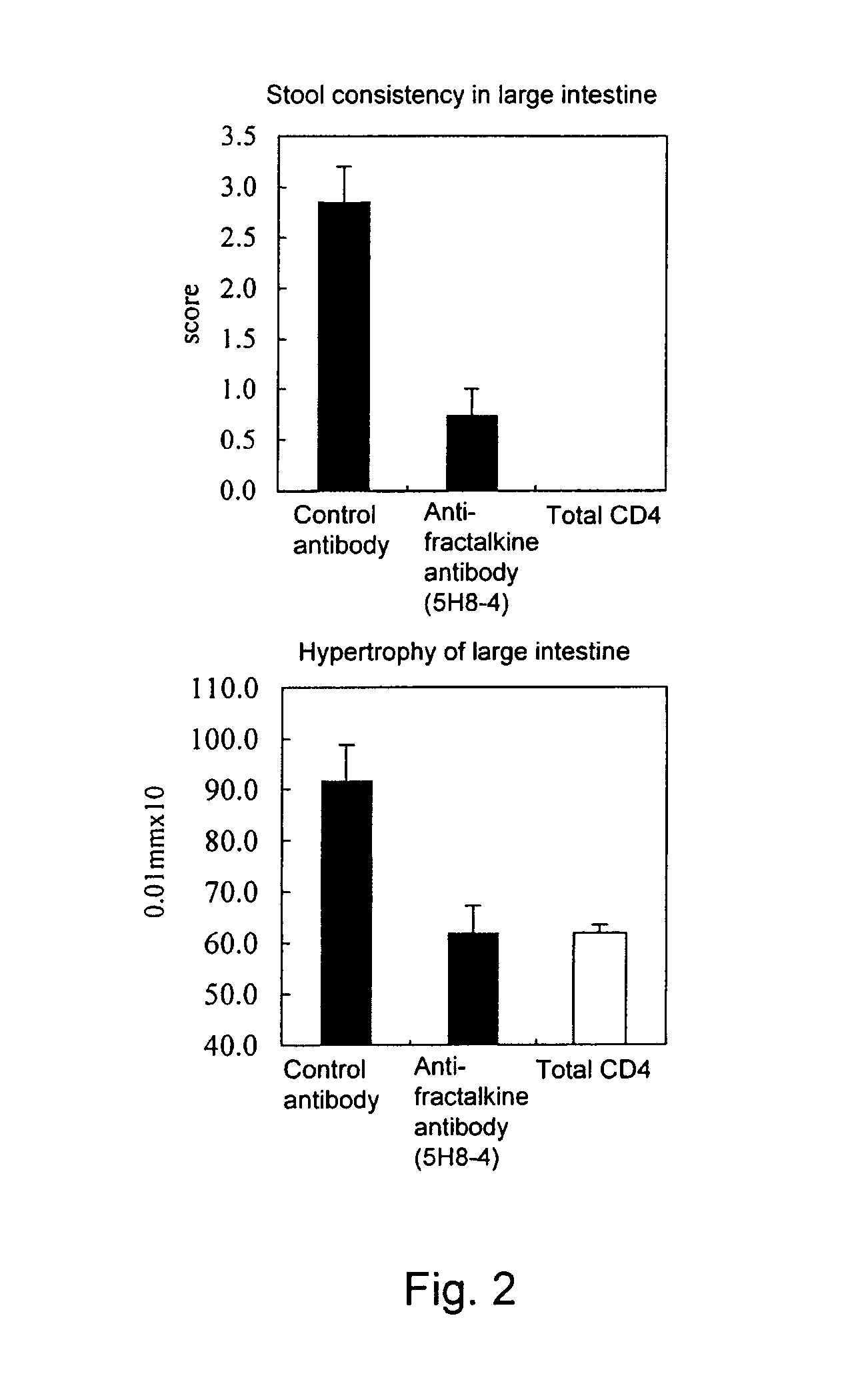Treating inflammatory diseases with antibodies that inhibit fractalkine-CXCR1 interaction
a technology of fractalkine and cxcr1 is applied in the field of inflammatory disease treatment agents, which can solve the problems of inability to inhibit the function of these cells, no specific report on whether the production of tnf and inos by these cells is inhibited, and no promising drug that inhibits the inos activity has been launched. to achieve the effect of improving pathological conditions and inhibiting inos production
- Summary
- Abstract
- Description
- Claims
- Application Information
AI Technical Summary
Benefits of technology
Problems solved by technology
Method used
Image
Examples
example 1
Effect of Anti-Fractalkine Antibody (5H8-4) in Mouse Inflammatory Bowel Disease Model Transfused with CD4-Positive and CD45RB Strongly-Positive (CD4+CD45RBhigh) T Lymphocytes
(1) Preparation of Anti-Fractalkine Antibody (5H8-4)
[0103]The anti-fractalkine antibody (5H8-4) was prepared by the following method (Japanese Patent Laid-open No. 2002-345454). Mouse fractalkine (R&D) was used as an antigen. The antigen was mixed with TiterMax adjuvant, Armenian hamsters were immunized with the mixture, and booster immunizations were performed thereafter with the antigen alone. The antibody titer in the serum was measured by ELISA. Lymphocytes were isolated from the Armenian hamsters in which the antibody titer increased, the lymphocytes and P3 myeloma cells were mixed at a ratio of 5:1, and the cells were fused by using PEG (Boehringer). The hybridomas were cultured on a 96-well plate for one week by using RPMI-1640 / 10% FCS / HAT / 10% Origen HCF (ISGN). Then, ELISA was performed for the culture s...
example 2
Effect of Anti-Fractalkine Antibody (5H8-4) in Mouse Oxazolone-Induced Inflammatory Bowel Disease Model
(1) Method
[0110]As for the mouse oxazolone-induced inflammatory bowel disease model, reference was made to Iijima et al., J. Exp. Med., 199, 471-482, 2004. The abdomens of 8 to 10-week old male Balb / c mice (Charles River Laboratories Japan, Inc.) were shaved in an about 2-cm square. To each mouse, 150 μl each of 100% ethanol solution containing 3% 4-ethoxymethylene-2-phenyl-2-oxazolin-5-one (hereinafter referred to as oxazolone, Sigma) was applied. The animals were starved on the fourth day after the oxazolone sensitization, and on the fifth day, given an intestinal injection of 100 μl each of 50% ethanol / physiological saline containing 0.5% oxazolone at a site about 3 cm from the anus under diethyl ether anesthesia. As a negative control group, five normal Balb / c mice were given an intestinal injection of 100 μl each of 50% ethanol / physiological saline. To seven mice in each group...
example 3
Effect of Anti-Fractalkine Antibody (#126) in Mouse Oxazolone-Induced Inflammatory Bowel Disease Model
(1) Preparation of Anti-Fractalkine Antibody (#126)
[0114]Mouse fractalkine (Genzyme) and Titer Max™ Gold adjuvant were mixed, and then used to immunize Armenian hamsters two or more times, and the final immunization was further performed with the mouse fractalkine alone. The antibody titer in the serum was measured by ELISA using solid-phased fractalkine, and lymphocytes were isolated from Armenian hamsters in which the antibody titer increased. The lymphocytes and P3 myeloma cells were mixed at a ratio of 5:1, and cell fusion was performed by using PEG (Rosh). The hybridomas were cultured on a plate for one week by using RPMI-1640 / 10% FCS / HAT / 10% Origen HCF (ISGN). Then, the culture supernatant was assayed by ELISA using solid-phased fractalkine to identify positive wells. The hybridomas producing the anti-fractalkine antibodies were cloned by performing limiting dilution twice. By...
PUM
| Property | Measurement | Unit |
|---|---|---|
| body weight | aaaaa | aaaaa |
| body weight | aaaaa | aaaaa |
| body weight | aaaaa | aaaaa |
Abstract
Description
Claims
Application Information
 Login to View More
Login to View More - R&D
- Intellectual Property
- Life Sciences
- Materials
- Tech Scout
- Unparalleled Data Quality
- Higher Quality Content
- 60% Fewer Hallucinations
Browse by: Latest US Patents, China's latest patents, Technical Efficacy Thesaurus, Application Domain, Technology Topic, Popular Technical Reports.
© 2025 PatSnap. All rights reserved.Legal|Privacy policy|Modern Slavery Act Transparency Statement|Sitemap|About US| Contact US: help@patsnap.com



